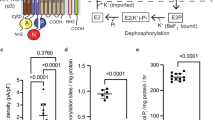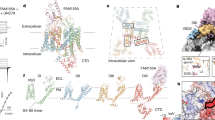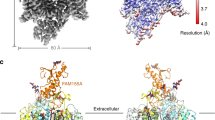Abstract
The Na+/K+-ATPase pumps three sodium ions out of and two potassium ions into the cell for each ATP molecule that is split, thereby generating the chemical and electrical gradients across the plasma membrane that are essential in, for example, signalling, secondary transport and volume regulation in animal cells. Crystal structures of the potassium-bound form of the pump revealed an intimate docking of the α-subunit carboxy terminus at the transmembrane domain1,2. Here we show that this element is a key regulator of a previously unrecognized ion pathway. Current models of P-type ATPases operate with a single ion conduit through the pump3,4,5, but our data suggest an additional pathway in the Na+/K+-ATPase between the ion-binding sites and the cytoplasm. The C-terminal pathway allows a cytoplasmic proton to enter and stabilize site III when empty in the potassium-bound state, and when potassium is released the proton will also return to the cytoplasm, thus allowing an overall asymmetric stoichiometry of the transported ions. The C terminus controls the gate to the pathway. Its structure is crucial for pump function, as demonstrated by at least eight mutations in the region that cause severe neurological diseases6,7. This novel model for ion transport by the Na+/K+-ATPase is established by electrophysiological studies of C-terminal mutations in familial hemiplegic migraine 2 (FHM2) and is further substantiated by molecular dynamics simulations. A similar ion regulation is likely to apply to the H+/K+-ATPase and the Ca2+-ATPase.
This is a preview of subscription content, access via your institution
Access options
Subscribe to this journal
Receive 51 print issues and online access
$199.00 per year
only $3.90 per issue
Buy this article
- Purchase on Springer Link
- Instant access to full article PDF
Prices may be subject to local taxes which are calculated during checkout




Similar content being viewed by others
Accession codes
References
Morth, J. P. et al. Crystal structure of the sodium–potassium pump. Nature 450, 1043–1049 (2007)
Shinoda, T., Ogawa, H., Cornelius, F. & Toyoshima, C. Crystal structure of the sodium–potassium pump at 2.4 Å resolution. Nature 459, 446–450 (2009)
Olesen, C. et al. The structural basis of calcium transport by the calcium pump. Nature 450, 1036–1042 (2007)
Takeuchi, A., Reyes, N., Artigas, P. & Gadsby, D. C. The ion pathway through the opened Na+,K+-ATPase pump. Nature 456, 413–416 (2008)
Toyoshima, C. & Nomura, H. Structural changes in the calcium pump accompanying the dissociation of calcium. Nature 418, 605–611 (2002)
Morth, J. P. et al. The structure of the Na+,K+-ATPase and mapping of isoform differences and disease-related mutations. Phil. Trans. R. Soc. B 364, 217–227 (2009)
Blanco-Arias, P. et al. A C-terminal mutation of ATP1A3 underscores the crucial role of sodium affinity in the pathophysiology of rapid-onset dystonia-parkinsonism. Hum. Mol. Genet. 18, 2370–2377 (2009)
Toyoshima, C., Nakasako, M., Nomura, H. & Ogawa, H. Crystal structure of the calcium pump of sarcoplasmic reticulum at 2.6 A resolution. Nature 405, 647–655 (2000)
Li, C., Geering, K. & Horisberger, J. D. The third sodium binding site of Na,K-ATPase is functionally linked to acidic pH-activated inward current. J. Membr. Biol. 213, 1–9 (2006)
Ogawa, H. & Toyoshima, C. Homology modeling of the cation binding sites of Na+K+-ATPase. Proc. Natl Acad. Sci. USA 99, 15977–15982 (2002)
Meier, S., Tavraz, N. N., Durr, K. L. & Friedrich, T. Hyperpolarization-activated inward leakage currents caused by deletion or mutation of carboxy-terminal tyrosines of the Na+/K+-ATPase α subunit. J. Gen. Physiol. 135, 115–134 (2010)
Toustrup-Jensen, M. S. et al. The C-terminus of Na+,K+-ATPase controls Na+ affinity on both sides of the membrane through Arg935 . J. Biol. Chem. 284, 18715–18725 (2009)
Yaragatupalli, S., Olivera, J. F., Gatto, C. & Artigas, P. Altered Na+ transport after an intracellular alpha-subunit deletion reveals strict external sequential release of Na+ from the Na/K pump. Proc. Natl Acad. Sci. USA 106, 15507–15512 (2009)
Riant, F. et al. ATP1A2 mutations in 11 families with familial hemiplegic migraine. Hum. Mutat. 26, 281 (2005)
Jen, J. C. et al. Prolonged hemiplegic episodes in children due to mutations in ATP1A2. J. Neurol. Neurosurg. Psychiatry 78, 523–526 (2007)
Holmgren, M. et al. Three distinct and sequential steps in the release of sodium ions by the Na+/K+-ATPase. Nature 403, 898–901 (2000)
Vasilyev, A., Khater, K. & Rakowski, R. F. Effect of extracellular pH on presteady-state and steady-state current mediated by the Na+/K+ pump. J. Membr. Biol. 198, 65–76 (2004)
Anselm, I. A., Sweadner, K. J., Gollamudi, S., Ozelius, L. J. & Darras, B. T. Rapid-onset dystonia-parkinsonism in a child with a novel ATP1A3 gene mutation. Neurology 73, 400–401 (2009)
Zanotti-Fregonara, P. et al. [123I]-FP-CIT and [99mTc]-HMPAO single photon emission computed tomography in a new sporadic case of rapid-onset dystonia–parkinsonism. J. Neurol. Sci. 273, 148–151 (2008)
Bas, D. C., Rogers, D. M. & Jensen, J. H. Very fast prediction and rationalization of pKa values for protein-ligand complexes. Proteins 73, 765–783 (2008)
Skou, J. C. & Esmann, M. Effects of ATP and protons on the Na : K selectivity of the (Na+ + K+)-ATPase studied by ligand effects on intrinsic and extrinsic fluorescence. Biochim. Biophys. Acta 601, 386–402 (1980)
Jewell-Motz, E. A. & Lingrel, J. B. Site-directed mutagenesis of the Na,K-ATPase: consequences of substitutions of negatively-charged amino acids localized in the transmembrane domains. Biochemistry 32, 13523–13530 (1993)
Yamamoto, S., Kuntzweiler, T. A., Wallick, E. T., Sperelakis, N. & Yatani, A. Amino acid substitutions in the rat Na+, K(+)-ATPase alpha 2-subunit alter the cation regulation of pump current expressed in HeLa cells. J. Physiol. (Lond.) 495, 733–742 (1996)
Burnay, M., Crambert, G., Kharoubi-Hess, S., Geering, K. & Horisberger, J. D. Electrogenicity of Na,K- and H,K-ATPase activity and presence of a positively charged amino acid in the fifth transmembrane segment. J. Biol. Chem. 278, 19237–19244 (2003)
Jespersen, T., Grunnet, M., Angelo, K., Klaerke, D. A. & Olesen, S. P. Dual-function vector for protein expression in both mammalian cells and Xenopus laevis oocytes. Biotechniques 32, 536–538 540 (2002)
Price, E. M. & Lingrel, J. B. Structure–function relationships in the Na,K-ATPase α subunit: site-directed mutagenesis of glutamine-111 to arginine and asparagine-122 to aspartic acid generates a ouabain-resistant enzyme. Biochemistry 27, 8400–8408 (1988)
Berendsen, H. J. C., Postma, J. P. M., Vangunsteren, W. F., Dinola, A. & Haak, J. R. Molecular dynamics with coupling to an external bath. J. Chem. Phys. 81, 3684–3690 (1984)
Berger, O., Edholm, O. & Jahnig, F. Molecular dynamics simulations of a fluid bilayer of dipalmitoylphosphatidylcholine at full hydration, constant pressure, and constant temperature. Biophys. J. 72, 2002–2013 (1997)
Acknowledgements
We acknowledge the Danish Center for Scientific Computing at the University of Southern Denmark, Odense, for computing resources. We thank D. Gadsby, N. Vedovato and A. Gulyas-Kovacs at the Rockefeller University, New York City, for technical advice and discussion, A. Skov Kristensen and M. H. Poulsen (University of Copenhagen) for supplies of oocytes, and M. J. Clausen, G. Hartvigsen and A. M. Nielsen for assistance with experimental procedures. We are grateful to C. Slayman and F. Ashcroft for discussions on electrogenic transport. H.P. was supported by a short-term travel fellowship from the European Molecular Biology Organisation, J.P.M. was supported by grants from the Carlsberg Foundation and the Lundbeck Foundation, and P.N. was supported by an Elite Researcher grant of the Danish Ministry of Science and Innovation and a Hallas-Møller stipend from the Novo Nordisk Foundation.
Author information
Authors and Affiliations
Contributions
H.P. designed experiments, performed the electrophysiological experiments, analysed the data and wrote the paper; H.K. designed, performed and analysed the molecular dynamics simulations; J.P.M. performed structural analyses and designed experiments, M.B. analysed the water-filled sarco-endoplasmic Ca2+-ATPase channel, O.G.M. supervised the molecular dynamics simulations, J.E. analysed the electrophysiological experiments, P.N. supervised the project, designed experiments and analysed the data. All authors commented on the paper.
Corresponding authors
Ethics declarations
Competing interests
The authors declare no competing financial interests.
Supplementary information
Supplementary Information
The file contains Supplementary Figures 1-7 with legends, Supplementary Tables 1-2 and additional References. (PDF 908 kb)
Supplementary Movie 1
This movie shows the C-terminal cytoplasmic pathway of Na+,K+-ATPase (MOV 1121 kb)
Rights and permissions
About this article
Cite this article
Poulsen, H., Khandelia, H., Morth, J. et al. Neurological disease mutations compromise a C-terminal ion pathway in the Na+/K+-ATPase. Nature 467, 99–102 (2010). https://doi.org/10.1038/nature09309
Received:
Accepted:
Published:
Issue Date:
DOI: https://doi.org/10.1038/nature09309
This article is cited by
-
Structure and function of H+/K+ pump mutants reveal Na+/K+ pump mechanisms
Nature Communications (2022)
-
K+ binding and proton redistribution in the E2P state of the H+, K+-ATPase
Scientific Reports (2018)
-
The CAPOS mutation in ATP1A3 alters Na/K-ATPase function and results in auditory neuropathy which has implications for management
Human Genetics (2018)
-
Glutamate Water Gates in the Ion Binding Pocket of Na+ Bound Na+, K+-ATPase
Scientific Reports (2017)
-
Transition metal binding selectivity in proteins and its correlation with the phylogenomic classification of the cation diffusion facilitator protein family
Scientific Reports (2017)
Comments
By submitting a comment you agree to abide by our Terms and Community Guidelines. If you find something abusive or that does not comply with our terms or guidelines please flag it as inappropriate.



